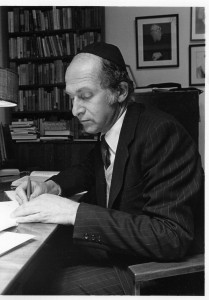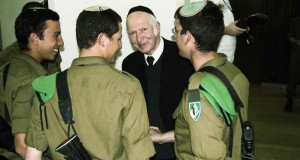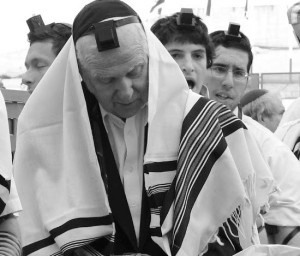Strength and Splendor: A Tribute to Rav Aharon Lichtenstein
By: David Shatz
“The voice of the Lord is strength (koach), the voice of the Lord is splendor (hadar)” (Psalms 29:6). Commenting on this verse, Rav Aharon Lichtenstein, zt”l, suggested that “koach” refers to God’s imposition of His authority, while “hadar” refers to the beauty of His commands.1 This duality of koach and hadar applies to great rabbinic figures as well. At Rav Lichtenstein’s funeral, Rav Ezra Bick, a RaM at Yeshivat Har Etzion who studied with Rav Aharon fifty years ago at Yeshiva University and later became a colleague, beautifully portrayed his relationship to his rebbi as, initially, that of eved to adon, servant to master. This, one might say, was the “koach” aspect of a rosh yeshivah. In this capacity Rav Lichtenstein inspired profound respect for his authority. But what Rav Bick’s and virtually every other hesped for Rav Lichtenstein has also pointed to is the dimension of hadar, the splendor and beauty of both his Torah and his outer and inner self.2
The eulogies have captured many aspects of this hadar: breathtaking brilliance, integrity, humility, moral sensitivity and commitment, depth of mind and soul, diligence and dedication, kibbud av vaem, devotion to family, concern for students, care and compassion for all people, courage, and a ceaseless sense of being an eved Hashem, of experiencing yir’at Shamayim, and of living in God’s presence. It is extraordinarily difficult for me to identify characteristics of Rav Aharon that others have overlooked–and I will not attempt to. But I want to offer a framework: to draw from images in Chazal and from experiences of mine which–in my effort to grapple with an immeasurable loss–I have found personally resonant and vivid.
I was not formally a talmid of Rav Lichtenstein, and I did not attend Yeshivat Har Etzion. But I did have the privilege of interacting with him and his talmidim on many occasions. Even for simply having observed him and heard him, I am inexpressibly grateful. He was, for me and myriad others who were not technically his students, not only a teacher but a beacon–we walked by his light, with reverence and love.
One aspect of Rav Lichtenstein’s hadar can be captured by a statement of Rabban Shimon ben Gamliel. “We do not erect monuments for tzaddikim. Their words are their memorials (divreihem hen hen zichronan)” (Yerushalmi Shekalim 2:5 [7a]).
What did Rabban Shimon ben Gamliel mean? The common understanding is that when people have communicated Torah in conversations, addresses and writings, they do not require physical monuments as memorials; people will remember them by studying what they spoke and wrote, or even just by knowing of their standing and achievements. Their words, oral and written, stand as monuments. The practice of referring to great Torah scholars by the names of their works (e. g., “the Avnei Nezer”) reinforces this idea, as does the fact that gedolim generally do not speak about their personal lives.
But if we allow ourselves some homiletic license, we can add a layer to this idea. Divreihem hen hen zichronan does not mean merely that you study what they stated; it means that through what they spoke and wrote you can gain insight into who they were and how they lived. In the case of some people, there is no ready separation between the cheftza and the gavra, between what they produced and who they were. Hence you may utilize their writings and discourses not just as cheftza shel Torah, as intellectual entities, but rather as windows into their personalities. Just as you can sometimes “read a person like a book,”3 you can sometimes read a book like a person.
The writings of Rav Lichtenstein tell us much about who he was. I refer not only to substance but to style, to form as well as content. His conviction that “the world is complex and the human being is complex”4 is matched by a dialectical style that embraces complexity and evinces an exquisite sensibility of balance.5 He sought to balance a host of values, many of which are often absolutized to the exclusion of the others. Rav Lichtenstein recognized that, on most issues, arguments can be marshalled on either side. Often he spells out the other side’s arguments more robustly than even its adherents do, and he formulates and fields objections to his views that the other side may not have thought of, and that a less intellectually honest author might have suppressed. His psychological depth and sensitivity enabled him to anticipate and articulate psychological and not only logical obstacles to accepting his views. The integrity and incisiveness of this kind of presentation edifies readers and inspires authors. While he drew boundaries and stated his opinions and criticisms forcefully and at times sharply, he acknowledged the legitimacy of other positions within the boundaries. Not coincidentally, his derech halimmud (method in Talmud study) was marked by an appreciation of alternative ways of looking at a topic, even ones that seemed only marginally plausible.6 Where there are legitimate options, he approximates the refined, respectful approach that Beit Hillel adopted in debating Beit Shammai–in virtue of which Beit Hillel merited that we follow their rulings (Eruvin 13b). And the elegance of his prose, the rich sensitivity to nuance, flowed from an elegance of personality. Being alert to these facets of Rav Lichtenstein’s writing makes one all the more conscious of how blatantly and painfully absent such qualities are in so many writers and speakers, and in so many places and settings. Divreihem hen hen zichronan.
A trait of Rav Lichtenstein that has been remarked on repeatedly was his unceasing consciousness of the Ribbono shel Olam and his yir’at Shamayim at every moment. Here, too, writings are revealing. This is not an author spewing abstractions or false pieties; the words clearly come from the deepest place. As he put it to Rav Haim Sabato, “I feel closeness to Hakadosh Barukh Hu more than to anything else.” “There is nothing of which I am more sure . . . than emunah.”7 Speaking of “the duties of the heart” that Judaism requires in response to suffering, he says, “Response to suffering cannot be divorced from the totality of religious experience, and the ability to integrate religious solutions is a function of the totality of faith and commitment . . . The key to confronting suffering in a Jewish way . . . entails reaffirmation of one’s fundamental Yahadut.”8 That “totality of faith and commitment” is not merely stated; it is felt by readers on every page. So, too, when he depicts the study of Torah (as he often does) as an experience of God.
Note that Rabban Shimon ben Gamliel applied his point not to chachamim, but to those who are (also) tzaddikim. Chachamim can write wonderful abstractions, but these do not always grow out of their personality, and do not always reveal the person. But in the case of chachamim who are also tzaddikim, persona and product are linked; character shines through even the most strenuous of intellectual exercises.
A second aspect of Rav Lichtenstein’s hadar was the dedication and effort he invested in every task, along with his remarkable comportment in carrying out the task. Let me illustrate with one example.
One of the many venues in which Rav Lichtenstein communicated his ideas was the Orthodox Forum. Convened in 1989 by Rabbi Dr. Norman Lamm, then president of Yeshiva University and rosh hayeshivah of the Rabbi Isaac Elchanan Theological Seminary (RIETS), and chaired for a quarter-century by Rabbi Robert Hirt, now vice president emeritus of RIETS (and succeeded as Forum chair by Rabbi Shmuel Hain), the Orthodox Forum is a think-tank devoted annually to vital intellectual and social issues in the Orthodox community. Papers are distributed in advance and are discussed at length by the group over the course of a day and a half. Rav Lichtenstein contributed over a dozen papers to the Forum–more than anyone else, never refusing an invitation–on the topics of suffering, egalitarianism, philanthropy, marriage and sexuality, tolerance, spirituality, Religious Zionism, the chief rabbinate, communal governance, yir’at Shamayim, the conceptual approach to learning, relating to the non-Orthodox, modernity, and human and social factors in halachic decision-making. (These papers originally were published in volumes of the Orthodox Forum, and many were later anthologized in Varieties of Jewish Experience and Leaves of Faith.) In the years he was able to attend, he set a model for participants–and not only by agreeing to write. Here he was, a man with extraordinary demands on his time and countless other commitments, who accommodated so many requests from strangers, and yet he could be counted on, always, to be a paragon of conscientiousness–reading the other dozen or so papers, annotating them, attending every session, focusing on what others had to say, commenting in discussions. Given his stature, he could easily have flitted in and out of sessions, or ignored the other papers. But instead he participated to the fullest extent.
How can anyone fail to see how characteristic this was: the sense of responsibility, the investment of effort, the meticulousness?9 I’m sure he reasoned: if I don’t involve myself in the work, what business do I have being here? And in discussions, even while he was in truth the group’s ultimate authority, he expressed himself without an iota of domineering or self-importance, never imposing himself as either the first or last word. He sat not at the head but rather, like everyone else, wherever there was a seat; and he waited to be called on like everyone else. His demeanor in the discussions leaves an indelible memory. It dovetails with patterns of conduct that others have depicted in fascinating anecdotes–stories that demonstrate extraordinary humility, conscientiousness, and wholehearted attention to whatever task was at hand.
There is another image from Chazal that evokes for me the hadar of this giant. The Talmud states, “Chacham adif minavi, the chacham is greater than the prophet” (Bava Batra 12b). Rav Kook suggested that the chacham is the one who plumbs minutiae, countless details and technicalities, including intricate details of halachot. The navi, by contrast, is the person of great ethical and spiritual vision. However, precisely because of the breadth and sweep of his vision, the navi does not grasp how the erosion of the performance of details, the seemingly small stuff, can “destroy the vessels in which is stored the exalted spirit.”10
Moshe Rabbeinu, says Rav Kook, “discerned simultaneously the claims of general principles as well as of the exacting demands of the particulars.” He was the ideal synthesis of chacham and navi. But in nevi’im short of Moshe, when practice of details began to erode, “what prophecy . . . could not accomplish . . . was accomplished by the sages . . . by raising many disciples and the assiduous study of the particular laws.” And even prophets then acknowledge, “chacham adif minavi.” Yet, while no one else is Moshe Rabbeinu, the ideal is the blend of broad ethical and spiritual vision with halachic details, of halichot with halachot, in Chazal’s phraseology (Megillah 28b).
Institutions have an identity, and that identity is forged by the figures at their helm. When you view Rav Lichtenstein’s persona and the persona of Yeshivat Har Etzion (“Gush”), the profile that he and Rav Yehuda Amital, zt”l, created for the institution, you find the integration of dikdukei halachah–halachic details studied in the most complex and rigorous ways–with vast horizons of machashavah and ethical vision. For example, Rav Lichtenstein insisted that Torah study must involve even massechtot that are no longer relevant in our day; in fact it is precisely in studying the practically irrelevant that one manifests submission to the Ribbono shel Olam. But in him were both halachot and halichot, the allegiance to both the particulars and the broad, grand ideals of Judaism–the seemingly minute and the palpably momentous–and the frequent anchoring of machashavah and of morality in halachic particulars. Halachah is central in his thought, to be sure, and not all particular laws are thought to be manifestations of the grand vision; but neither vision nor details should be robbed of their due.11 Emulating their rosh hayeshivah, the same talmidim who work intensively on Kodashim and Taharot produce work in Tanach and machashavah, and integrate Torah with general chochmah. They are also imbued with a vision of the significance of the State of Israel, and they participate in its life from both near and afar.
Rarely does one encounter the sweep and majesty of Rav Aharon’s vision; more rarely still is such vision combined with the power and brilliance of his study of halachah.
It is customary to refer to a Torah giant as an “ilan gadol,” a tall tree. Rav Aharon Lichtenstein was an ilan gadol, and we were blessed to partake of the ilan’s fruit–the peri etz hadar.
There is virtually no topic in Jewish life that Rav Lichtenstein did not address, and nothing in his shiurim, writings, and conduct from which we cannot learn. More than one thousand works of his have appeared in print, either from his own pen or from those of students adapting his shiurim and sichot; and we have as well, especially now, many a ma’aseh rav, that is, a wealth of awe-inspiring anecdotes and testimonials about how he lived. More materials are bound to follow. May the man–and his life and work and aspirations and achievements and vision–be a source of blessing for the generations. Yehi zichro baruch.
Notes
1. See “Being Frum and Being Good: On The Relationship Between Religion and Morality,” in By His Light: Character and Value in the Service of God: Based on Addresses by Rabbi Aharon Lichtenstein, adapted by Rabbi Reuven Ziegler (Alon Shevut: 2nd edition, 2003), 107-108. I have taken some liberty here with the vort; for example, in the original context, Rav Lichtenstein is distinguishing between two categories of mitzvot rather than two aspects of each mitzvah.
2. Note that many translate hadar as “majesty.” This, too, was a characteristic of Rav Lichtenstein.
3. As commonly used, and as I use it here, this expression means that sometimes a person’s character and motivations are easily detected and utterly transparent. In a different use of this expression, Rav Yosef Dov Soloveitchik, zt”l, remarked that “Zeh sefer toledot Adam, This is the book of the events of Adam,” (Genesis 5:1) can mean, “This is the book of the events of the human being (adam),” and that one must study a person as if studying a book. This idea is quoted by Rav Lichtenstein in “The Rav zt”l in Retrospect: Divrei Hesped,” in Leaves of Faith, vol. 1 (Jersey City, New Jersey, 2003), 207-08.
4. See Rav Haim Sabato, Mevakshei Panecha: Sichot im HaRav Aharon Lichtenstein (Tel-Aviv, 2011), 48.
5. This theme is also found in Yoel Finkelman, “Canon and Complexity,” in a special issue of Tradition ed. Yitzchak Blau, Alan Jotkowitz, Reuven Ziegler (Winter 2014): 69-85.
6. See “The Conceptual Approach to Torah Learning: The Method and Its Prospects,” in Leaves of Faith, 1: 56. Note the contrast drawn there with “Classical Brisk.”
7. Mevakshei Panecha, 10.
8. “The Duties of the Heart and the Response to Suffering,” Leaves of Faith, vol. 2 (Jersey City, New Jersey, 2004 ), 148. (Originally in an Orthodox Forum volume edited by Rabbi Shalom Carmy.)
9. I was told that Rav Yosef Adler likewise alluded to Rav Lichtenstein’s diligence at the Forum.
10. See Rav Kook, Orot, 120-21. The translations are from Ben Zion Bokser, Abraham Isaac Kook (New York, 1978), 253-55. See also Rav Kook, Orot haTorah 3:8, cited by Rav Sabato in a question he poses to Rav Lichtenstein in Mevakshei Panecha, 32.
11. On the interrelated topics of methods of Talmud study, yeshivah education, and the centrality of halachah, see the following: “Why Learn Gemara?,” Leaves of Faith, 1 (Jersey City, New Jersey, 2003), 1-17 (esp. 8-9); “The Conceptual Approach to Torah Learning,” in Leaves of Faith, 1:19-60; Mevakshei Panecha, 30-50, 249-78. See also the strong words of caution in Shlomo Zuckier and Shalom Carmy, “An Introductory Biographical Sketch of R. Aharon Lichtenstein,” in the special issue of Tradition mentioned above, p. 6. “To ignore or minimize the emphasis on Torah study, and on Talmud, in R. Lichtenstein’s thought, just because he has championed broad universal concerns and advocated the study of liberal arts as a vehicle to religious wholeness, is a distortion of his teaching to the point of making it unrecognizable.” The distortion also diminishes the awesomeness of his true achievement.
Dr. David Shatz is university professor of philosophy, ethics and religious thought at Yeshiva University, editor of The Torah u-Madda Journal and editor of the series MeOtzar HoRav: Selected Writings of Rabbi Joseph B. Soloveitchik. In the latter capacity, he was afforded the opportunity to interact with Rav Lichtenstein, zt”l, and tibbadel l’chayyim, Dr. Tovah Lichtenstein. The author wishes to thank the Yeshivat Har Etzion alumni with whom he exchanged thoughts about Rav Lichtenstein in the months since his passing, and who offered feedback on an earlier version of this essay: Rabbis Elie Berman, Yitzchak Blau, Nati Helfgot, Aaron Segal and Reuven Ziegler. He also wants to thank Dr. David Berger, Dr. Yoel Finkelman, Rabbi Robert Hirt and Paul Reinstein for their comments.



